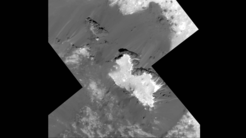Dawn: Unique Views of Occator Crater
NASA’s Dawn spacecraft has returned first images from its lowest orbit around dwarf planet Ceres. They show parts of Occator Crater as detailed as never before.
Since the beginning of June, NASA’s Dawn spacecraft has been orbiting on a new, highly elliptical trajectory around Ceres that dives 35 kilometers above the surface of the dwarf planet. This is closer than Dawn has ever been to Ceres since its arrival in March 2015. From this distance, high-resolution images of parts of Occator Crater are now available. They show dramatic landslides and offer the best view yet of its characteristic bright spots.

Since the beginning of Dawn’s mission to Ceres, Occator Crater has played a crucial role. In the center of the 90-kilometer-wide impact crater, a pronounced depression can be found featuring a striking, asymmetrical central dome. Scientists have identified this dome as the scene of earlier cryovolcanic activity: researchers from the Max Planck Institute for Solar System Research (MPS) in Germany concluded that saline solutions emerged from there. The water evaporated, leaving behind the eye-catching, bright deposits that were already visible in the approach phase to Ceres. Measurements with the visible and infrared mapping spectrometer VIR have identified this material as sodium carbonate. Other bright speckles in the eastern part of the crater are also likely vents that allowed a water-salt-mixture to rise to the surface from a deeper brine reservoir.

The current images now show numerous sections of Occator Crater from an altitude of 35 kilometers and with a resolution less than 5 meters per pixel. "The data exceeds all our expectations," Dr. Andreas Nathues from the MPS, Framing Camera Lead Investigator, says. In the new images, the surface is now ten times better resolved than in the best images from the previous three years.
Impressive avalanches reveal themselves in the new views of the eastern wall of Occator Crater: there are clear signs that material has been recently moving down the slopes; some of it remains stuck halfway. Other images allow a close look at the interplay of bright and dark material in the eastern part of the crater. "We now hope to understand how the bright deposits outside the crater center came about - and what they tell us about Ceres' interior," says Nathues. Various analyses of the past years suggest that Ceres has a water-rich crust. Small impacts and landslides regularly expose ice at the surface, which produces a thin exosphere of water vapor.

Last week, the Dawn mission's possibly last orbit correction successfully took the spacecraft on a trajectory targeting the center of Occator Crater. In the next few weeks, Dawn is expected to send more shots of the crater to Earth.
Dawn's mission to Vesta and Ceres is managed by the Jet Propulsion Laboratory for NASA's Science Mission Directorate in Washington. Dawn is a project of the directorate's Discovery Program, managed by NASA's Marshall Space Flight Center in Huntsville, Alabama. UCLA is responsible for overall Dawn mission science. Orbital ATK, Inc., of Dulles, Virginia, designed and built the spacecraft. JPL is managed for NASA by the California Institute of Technology in Pasadena. The framing cameras were provided by the Max Planck Institute for Solar System Research, Gottingen, Germany, with significant contributions by the German Aerospace Center (DLR) Institute of Planetary Research, Berlin, and in coordination with the Institute of Computer and Communication Network Engineering, Braunschweig. The framing camera project is funded by the Max Planck Society, DLR, and NASA. The spectrometer VIR was provided by the Italien Space Agency ASI and is operated by the National Institute for Astrophysics in Rome in collaboration with Selex Galileo.














